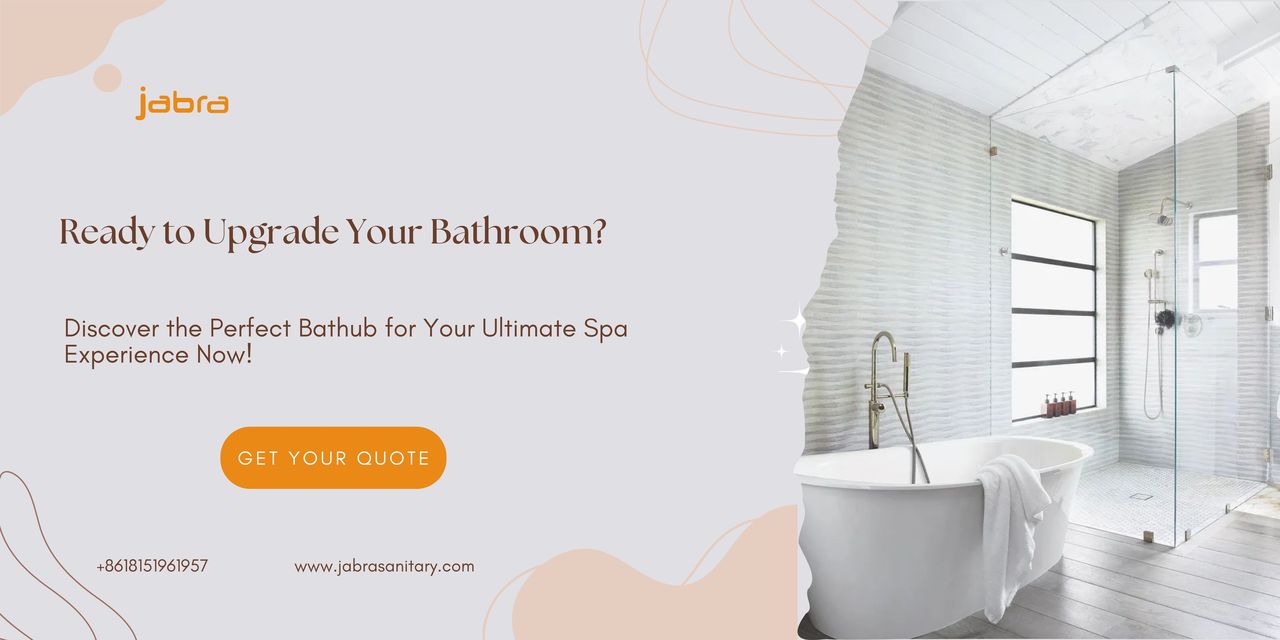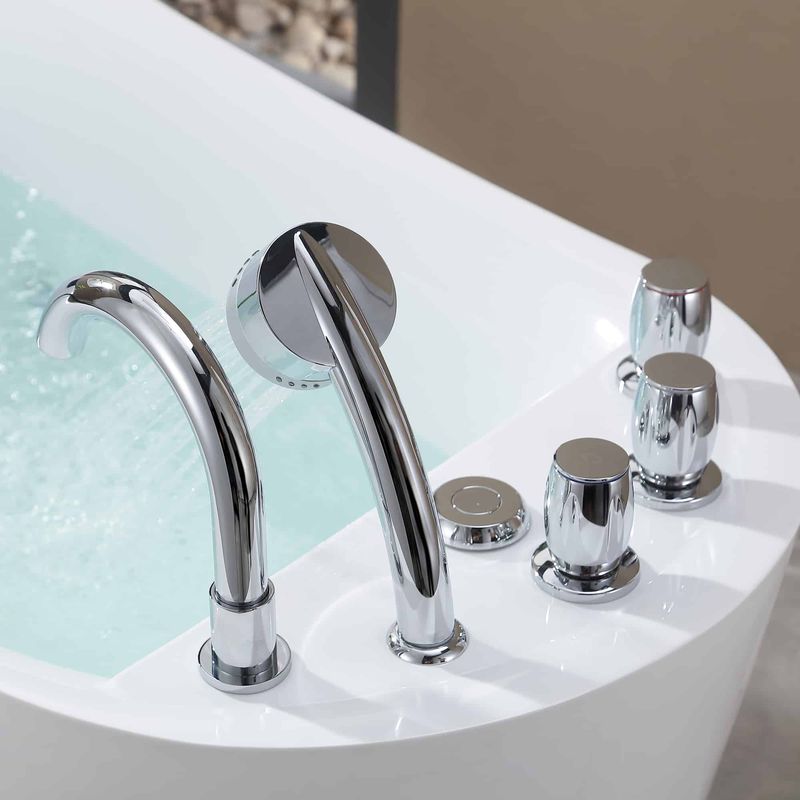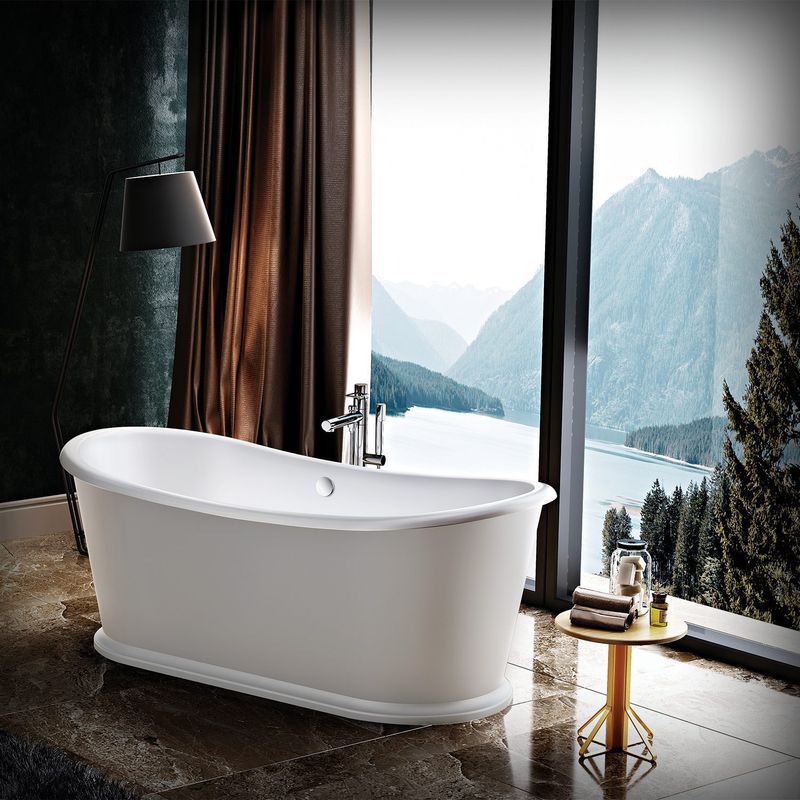 English
English
Jabra Sanitary is a sanitaryware supplier offering toilets, sinks, faucets, bathtubs, etc., at competitive prices. If you're a distributor, wholesaler, or project contractor, get a quote today!
 $23.9 Limited-time Offer
$23.9 Limited-time Offer Consignment Policy
Consignment Policy 20 Years of Experience
20 Years of Experience
When you relax in a bathtub, you might not think about how much water it holds, but understanding how many gallons are in a bathtub is important.
"Understanding your bathtub's capacity is crucial, especially when it comes to water conservation and maximizing the efficiency of your baths", says Dr. Jane Waters, a water resource expert, "By knowing how many gallons is in a bathtub and adjusting your water usage accordingly, you can enjoy a relaxing bath while being mindful of your environmental impact".
As the expert said, knowing how many gallons can a bathtub hold helps you make smarter decisions about water usage. Tubs come in all designs, shapes, and sizes, but how many gallons does the average bathtub hold? Read on to get the answer, compare tub water capacity vs. water usage, and learn how to reduce water usage!
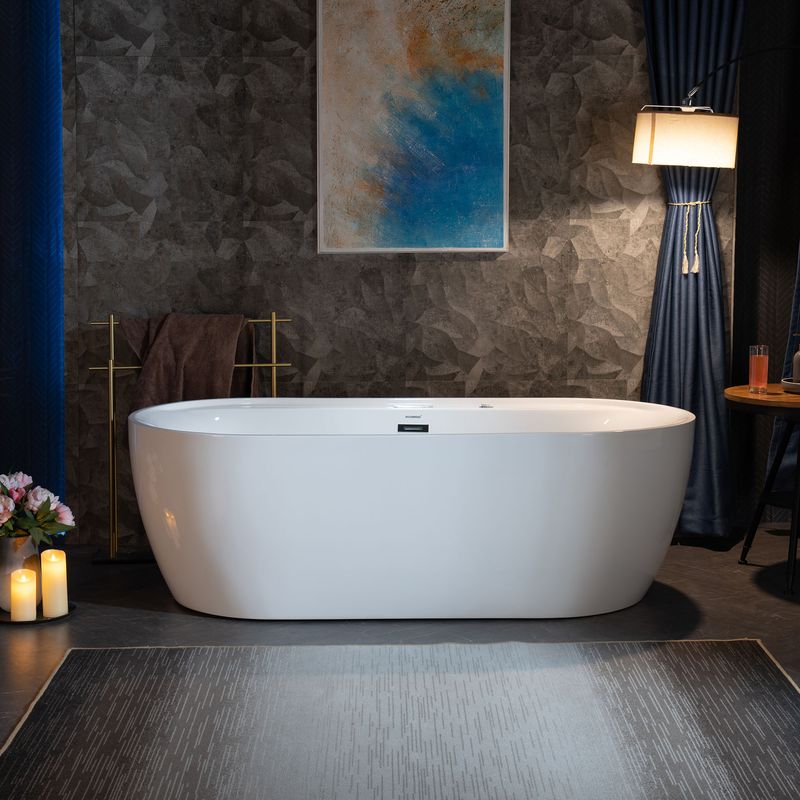
Table of Contents
How Many Gallons Can an Average, Smaller, and Larger Bathtub Hold?
Freestanding, Corner, Walk-in, and Other Tubs Capacity
How Do I Figure Out How Many Gallons Are in My Bathtub?
Key Factors That Affect Bathtub Water Capacity
How to Calculate Your Bathtub's Gallon Capacity
Bathtub Water Capacity vs. Water Usage
Tips to Reduce Water Usage
FAQs
Conclusion: Choosing the Right Bathtub Based on Water Capacity
How Many Gallons Can an Average, Smaller, and Larger Bathtub Hold?
Tub capacity is a factor that defines the interior tub space in gallons. The average tub capacity ranges from 40-70 gallons of water.
Smaller tubs, such as corner tubs, hold less water, while larger tubs, like soaking or jetted baths, can hold much more. This table tells you how many gallons fill a bathtub of different sizes:
Bathtub Type |
Water Capacity |
|---|---|
Smaller Bathtubs |
Around 40 gallons |
Standard Bathtubs |
50-70 gallons |
Large Bathtubs |
80-170+ gallons |
Freestanding, Corner, Walk-in, and Other Tubs Capacity
The different bathtub capacity types can vary widely depending on their design and intended use. Each bathtub is built with a specific purpose in mind and has a direct bearing on the amount of water they hold.
Below is a breakdown of various bathtub types, including their average bathtub size gallons and liters.
Bathtub Type |
Average Gallons |
Average Liters |
|---|---|---|
Corner Tub |
90-100 gallons |
340-380 liters |
Freestanding Tub |
60-80 gallons |
230-300 liters |
Walk-in Tub |
50-70 gallons |
190-265 liters |
Alcove Tub |
50-60 gallons |
190-225 liters |
Clawfoot Tub |
40-60 gallons |
150-225 liters |
Tub/Shower Combo |
60-80 gallons |
230-300 liters |
2-Person Tub |
100-170+ gallons |
380-640+ liters |
Jetted Bath |
80-100 gallons |
300-380 liters |
How Do I Figure Out How Many Gallons Are in My Bathtub?
There are several easy ways to determine your bathtub's water capacity.
- Check Your Hot Tub Manual: The manual typically provides the exact water capacity of your hot tub.
- Call the Spa Dealership: The dealership can provide you with the water capacity based on the model.
- Call the Manufacturer: Contact the manufacturer directly for precise specifications on your hot tub's water capacity.
- Google It: Search the make and model of your hot tub online to find the water capacity information.
Key Factors That Affect Bathtub Water Capacity
The water capacity of a bathtub and how it's used can vary significantly depending on several key factors, beyond just the basic size.
Below are the most important considerations when determining the water capacity of a bathtub:
Shape
The shape of a bathtub can greatly impact its water capacity. Oval and corner tubs often have more interior space compared to standard rectangular tubs.
For example, oval tubs tend to have a deeper and more spacious design that allows for a fuller soak. On the other hand, corner tubs are designed to fit into a compact space.
Size and Dimensions
The size and dimensions of a bathtub are directly linked to its water capacity. Larger tubs are typically deeper and longer.
Smaller tubs, like those for one person or designed for small bathrooms, are more compact and have a reduced water capacity.
First, know how many gallons are in a standard bathtub. Second, compare it with larger and smaller ones to make the perfect choice for your preferred bathroom.
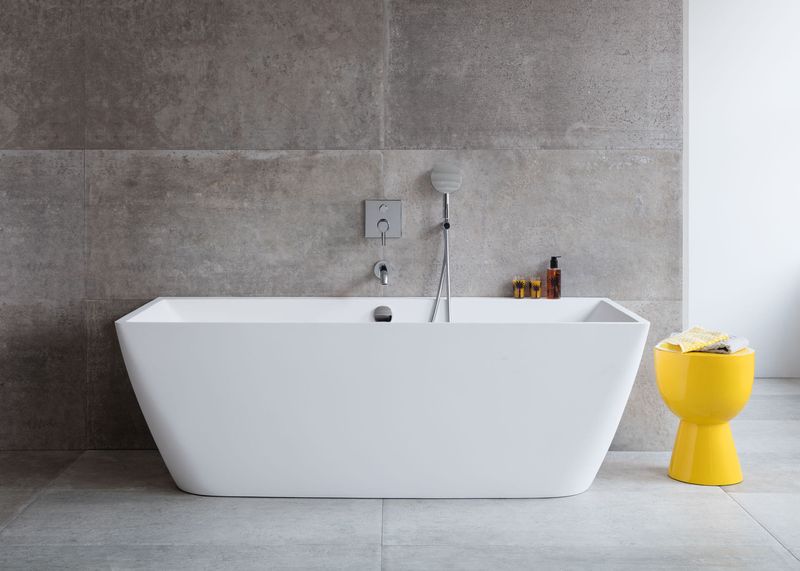
Water Displacement
Water displacement is an important factor when determining how many gallons can a bathtub hold. The larger the person, the more water is displaced.
This means the total amount of water required to fill the tub will be less than its total capacity once you're in it.
Overflow Level
The overflow drain in a bathtub prevents water from spilling over the sides. The position of the overflow drain affects how much water a tub can safely hold.
Therefore, it is necessary to decide how high is a bathtub. If you prefer filling the tub higher for a deeper soak, a tub with a higher overflow level will give you more leeway to add water without worrying about spillage.
Seat Function
Bathtubs that come with built-in seats may have a reduced water capacity. While these tubs are great for relaxation and accessibility, the seat function reduces the overall volume of water the tub can hold.
If you're looking for a tub that maximizes water capacity, you may want to choose one without a built-in seat.
Key Points to Remember:
- The water capacity of your bathtub depends on its size and dimensions.
- If the tub has seats, it typically holds less water, as the seats take up space.
- Larger tubs, such as 8-person models, will hold more water than smaller 2—or 3-person tubs, regardless of their shape.
How to Calculate Your Bathtub's Gallon Capacity
Knowing how many gallons are in a tub is an important step in understanding your water usage and optimizing your bath experience. You can easily calculate your bathtub's capacity by following a few simple steps.
Below is a step-by-step guide for measuring your bathtub and calculating its volume in gallons and cubic feet with the formula.
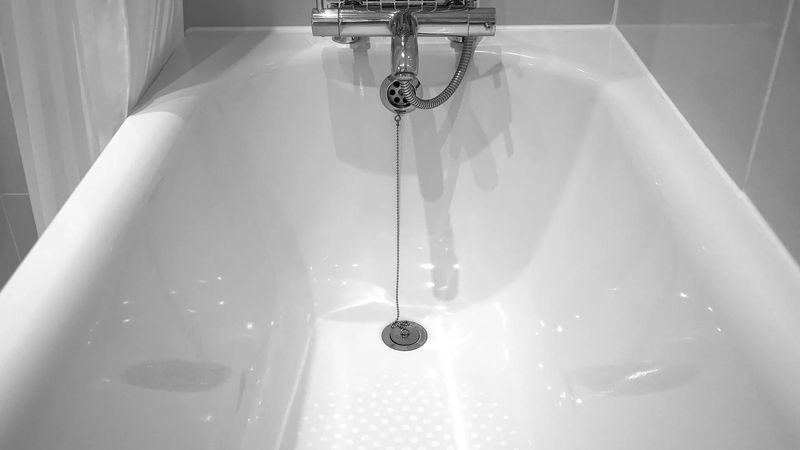
Measure the Length of the Bathtub
Begin by measuring the length of your bathtub from one end to the other. Measure along the interior, following the curve of the tub if necessary. This will give you the tub's full length in feet.
Measure the Width of the Bathtub
Second, measure the width of your bathtub. First, measure along the widest part, from side to side. Again, measure along the interior to ensure accuracy. If your bathtub has an irregular shape, take the widest measurement.
Measure the Depth of the Bathtub
The depth is the vertical distance from the bottom of the tub to the overflow drain (usually located a few inches from the top). This is the most critical measurement for determining how much water the tub can hold.
Multiply Length x Width x Depth
Once you have the three measurements (length, width, and depth), multiply them together to get the volume in cubic feet by using the following formula:
Length x Width x Depth = Volume in Cubic Feet
However, since the volume you calculate will be in cubic feet and you want to know the number of gallons, you will need to convert the cubic feet into gallons by using the following formula:
(Length x Width x Depth) x 7.48 = Gallons
Bathtub Water Capacity vs. Water Usage
To make an informed decision about what bathtub to choose, let's first compare how many gallons are in a bathtub between average bathwater usage and 10-minute shower water usage:
Water Usage |
Average Gallons |
|---|---|
Average Bath Water Usage |
35-50 gallons |
10-Minute Shower Water Usage |
25 gallons |
According to the Residential End Uses of Water Study, showers are tied with faucets as the second largest use of water at 11.1 gallons used per capita per day, or 19 percent of an individual's total use.
A standard bath typically uses 35 to 50 gallons, but deeper or larger tubs can use more, especially if filled higher. Your body also displaces some of the water, so the more you weigh, the less water the tub can hold.
Regarding the therapeutic benefits of baths, they offer relaxation effects regardless of more water usage. Warm water can help reduce stress, ease muscle pain, and improve blood circulation. Many people find the health benefits of a bath and choose a standard soaking tub.
When choosing between a bathtub or shower, it depends on personal preferences. If saving water is a priority, shorter showers with a water-saving showerhead are a good choice.
If you're looking for relaxation or relief from pain, a bath might be better. The decision can also depend on space—smaller bathrooms may prefer showers for convenience and water efficiency.
Tips to Reduce Water Usage
While enjoying a relaxing bath is a great way to unwind, it's important to consider ways to reduce water consumption without sacrificing comfort.
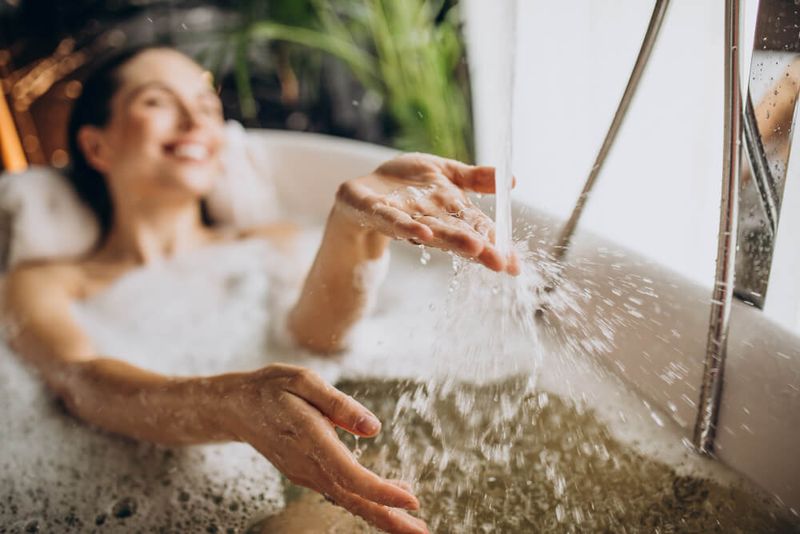
Fortunately, there are several strategies you can adopt to minimize water usage in the bathtub:
- Reuse Bath Water: If possible, reuse the bathwater for watering plants or other purposes.
- Select Heat Retaining Materials: Tubs made of materials like cast iron keep heat longer.
- Fill the Tub Halfway: Filling the tub halfway reduces the water you use while still offering a comfortable bath.
- Use a Low-Flow Showerhead: If you have a tub-shower combo, use a low-flow showerhead from a showerhead brand.
- Add Oil to the Water: A few drops of essential oils can help retain heat in the water, making your bath last longer.
FAQs
Understanding the water capacity of your bathtub and how to manage it effectively can raise a lot of questions.
Below are answers to some common FAQs about bathtub water usage and related concerns:
How long should it take for a bath to fill?
The time it takes to fill a bathtub can vary depending on several factors, including the flow rate of your faucet and the size of the tub.
On average, a standard bathtub takes 10 to 20 minutes to fill, assuming the flow rate is about 4-6 gallons per minute (gpm).
If you have a high-flow faucet or a large bathtub, it may take longer. Conversely, a low-flow faucet will fill the tub more slowly, which can be beneficial for water conservation but may take closer to 20 minutes or longer to fill.
How much water does a 5-foot bathtub hold?
A 5-foot bathtub is typically considered a standard size for most homes. The water capacity for a 5-foot bathtub generally ranges from 40 to 60 gallons (150 to 225 liters), depending on the tub's depth and design.
If you have a deeper or wider tub, it could hold more water, while a shallower 5-foot tub may hold closer to the lower end of that range.
Does a bath take more water than a shower?
Yes, generally, a bath uses more water than a shower. An average bath requires about 35 to 50 gallons of water, depending on the size of the tub. In contrast, a 10-minute shower typically uses around 25 gallons of water with a standard showerhead (2.5 gpm).
However, if you use a low-flow showerhead or take shorter showers, the water usage can be reduced significantly. While baths can be more water-intensive, they provide relaxation and therapeutic benefits that showers don't always match.
What is the average height of a bathtub?
The average height of a bathtub is typically around 14 to 16 inches from the floor to the rim of the tub. However, this can vary depending on the style of the tub.
For example, freestanding tubs or luxury models may have slightly taller rims, while alcove tubs may have a standard height.
How long does a 5-gallon shower last?
If you're using a 5-gallon shower, the duration depends on the flow rate of the showerhead. With a typical showerhead that has a flow rate of 2.5 gallons per minute (gpm), a 5-gallon shower would last approximately 2 minutes.
If you're using a low-flow showerhead with a flow rate of 1.5 gpm, the same 5 gallons of water would last about 3 minutes.
In practice, most people use more water in a shower, but a 5-gallon shower would be very short. This highlights the importance of a good water-efficient system for sustainable water use.
Conclusion: Choosing the Right Bathtub Based on Water Capacity
In summary, the standard tub capacity ranges from 40-70 gallons with larger tubs holding 100-170+ gallons.
Choosing the right bathtub goes beyond style and design - it's also about understanding the bathtub water capacity and how it impacts both your comfort and your water usage. Also, the bathroom size is one factor taken into account.
Balancing water capacity with water conservation efforts is key to managing your environmental footprint. If water conservation is important, consider opting for a smaller tub or filling it halfway.
Taking shorter baths or reusing bathwater for other purposes can also help reduce your water consumption. Additionally, materials like acrylic or cast iron can retain heat longer, reducing the need to top up with hot water.
Finally, choosing water-efficient fixtures, such as low-flow faucets, and being mindful of your bath duration can further contribute to water savings.
By finding the right bathtub size for your needs and practicing mindful water usage, you can enjoy a comfortable bath experience while also promoting an eco-friendly lifestyle.







